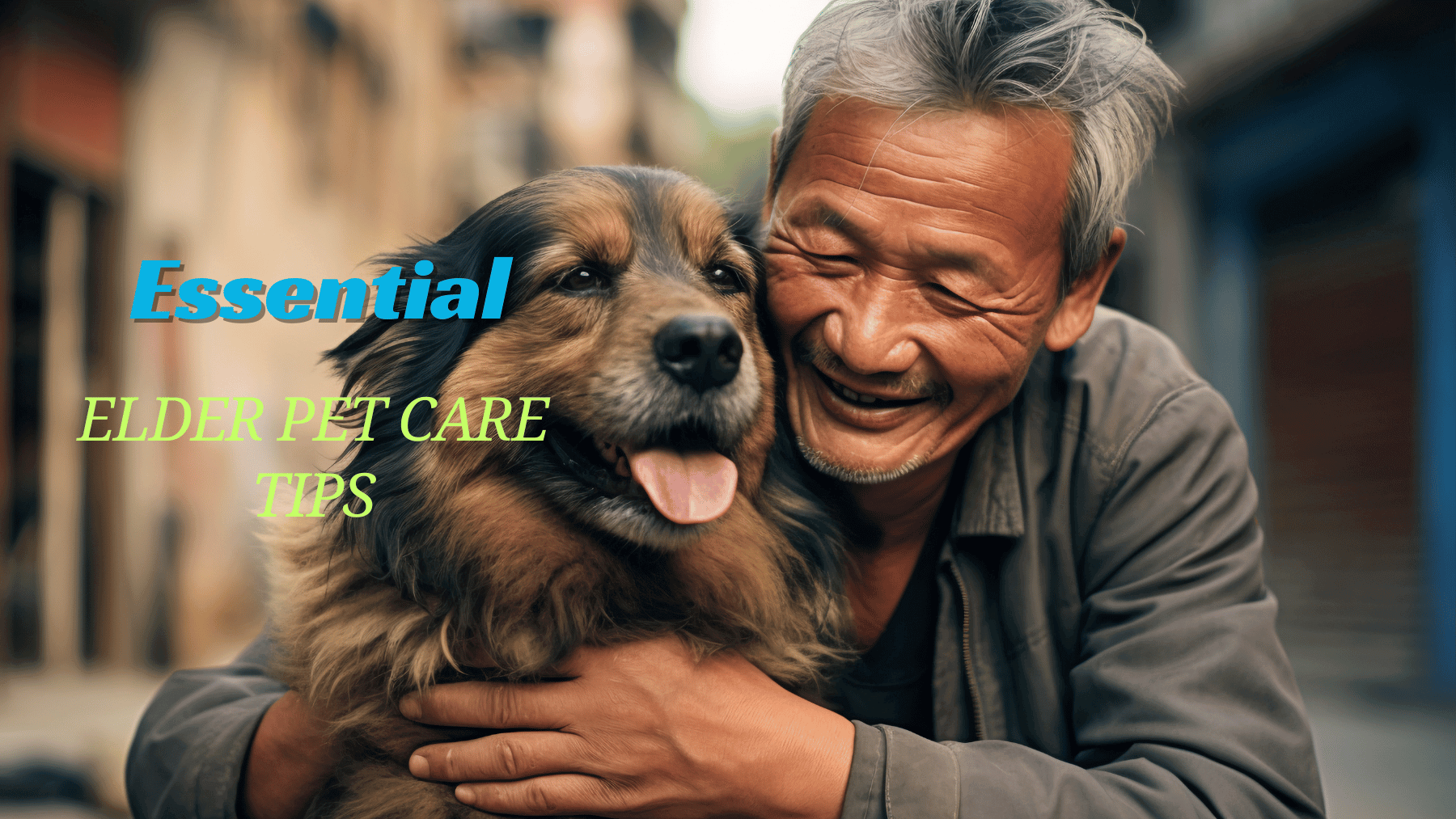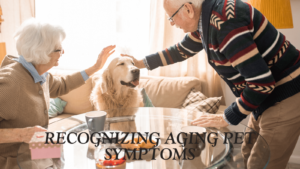“Elder Pet Care” is essential for the elderly pet. When pets reach maturity and into their golden years, so many challenges may arise that warrant consideration, from their movement to their nutrition.
Knowing how you can provide your pet care for their golden years is so important, and providing good “elder pet care” can make huge differences to your pet’s quality of life, and help your little buddy enjoy their old age comfortably and happily. This guide will outline the tips you need to help your senior pet age gracefully and happily.
Understanding Elder Pet Care: Why It’s Crucial for Senior Pets
Just like humans, our pets also go through numerous shifts physically and emotionally as they age, thus rendering “elder pet care” more significant. Pets, like humans, experience changes in their health, which can cause discomfort and troubles doing daily tasks. The first step toward effective “elder pet care” for your favorite friend is understanding how aging affects your pet.
In terms of training, senior pets tend to experience things like “pet mobility issues” — arthritis, stiffness or even degenerative disease that can make it difficult for them to get around. Such transformations can have a substantial effect on your pet’s quality of life, so it is essential to recalibrate your care routine.
One of the simplest ways to deal with these challenges is to provide your pet with a comfortable environment (like soft bedding and easy access to their favorite resting spots) that will help them feel more at ease. “Senior pet health” refers to all of the steps we can take to identify those symptoms in their early stages and provide the support they require.
Emotionally, older pets may feel anxious or confused, particularly if they develop “aging pet symptoms” such as vision or hearing loss. “Caring for senior dogs/cats” takes a lot of patience and understanding, as they may also experience cognitive dysfunction or behavioral changes.
These mood or behavior changes can be upsetting for both the pet and his or her owner, but the right interventions can help control these symptoms and help keep your senior pet safe and comfortable.
Moreover, “elderly pet care tips” stress on maintaining their veterinary visits. Routine monitoring is essential for detecting early indications of sickness or decline. These conditions such as heart disease or kidney failure can be treated better if detected earlier.
So is “senior pet nutrition” a big factor in their well-being? As pets get older, they also have different eating requirements and may require specialized diets to promote proper joint, bone and immune system health.
In the end, “elder pet care” is about making sure that as your pet ages, they remain comfortable, happy, and healthy. Taking the extra time to understand what your dog needs physically and emotionally and adjusting their lifestyle accordingly can be a great way to help maximize their life and strengthen your bond.
Senior Pet Health: Key Considerations for Aging Pets
As pets age, their health needs change, and “elder pet care” becomes vital to help them age comfortably and healthily. These senior pets are more susceptible to certain health problems, and knowing these concerns is essential to provide optimal care.
The intent of “elder pet care” is mainly to identify these problems early on and find solutions to help you pet enjoy their golden years, in comfort, whenever possible.
“Pet Mobility Issues” are among the most common complaints that senior pets face. Arthritis is common in older dogs and cats, and can lead to pain, stiffness and difficulty moving. These senior pet signs can interfere with their ability to walk, jump or and even go up stairs.
Mobility problems are key to “senior pet health.” Orthopedic beds, ramps, joint supplements — all these things can greatly enhance comfort. Low-impact activities like quiet walks or swimming can help keep senior pets’ joints flexible without straining them.
Dental disease is another common, but often ignored, condition affecting older pets. As pets get older, tartar buildup can even cause gum disease, tooth loss, or infections that impact their overall health. Regular dental care is one of the “elderly pet care tips” on your to-do list.
Tooth decay and associated health problems can be avoided by regular vet check-ups and professional cleanings. Equally, dental chews and prescription diets made with only senior pets in mind also help keep your dog’s mouth clean.
Loss of vision and hearing is also frequent as pets age. “Aging pet symptoms,” like struggling to respond to commands or a reduced interest in toys, may be signs of these sensory declines.
So, while complete blindness or deafness may not be fixed, your job as someone who is “caring for senior dogs/cats” is to adjust to new needs. Fosters or families willing to accommodate, including sticking to consistent environment and using touch or vibration cues for communication, can help senior pets adjust, Dr. Smith said.
A key aspect of “elder pet care” is making sure your senior pet is receiving proper nutrition. “Senior pet nutrition” needs to be customized for an aging pet’s metabolism, which slows with age.
Special diets can aid in maintaining a healthy weight, promoting joint health and ensuring your pet gets the proper nutrients needed to maintain muscle mass and energy levels.
Omega-3 fatty acids, antioxidants, and glucosamine-rich foods are all excellent supports for “senior pet health” and help relieve some of the aches and pains of aging. Collaborate with your vet to establish an ideal food regime for your pet’s body and health.
It highlights the importance of routine vet visits for catching these changes before they manifest into something worse. Regular visits will help your vet detect early signs of health problems, like heart disease, kidney failure or cancer, and work with you to create a long-term health plan for your aging pet.
In other words, “elder pet care” is about being aware of and taking proactive, preventative measures to treat common concerns of aging, including “pet mobility issues,” dental disease, vision/hearing loss, etc. Taking “senior pet care tips” to heart and helping your senior pet eat right will ensure your senior pet has a longer and more comfortable life.
Elder Pet Care Tips: Making Your Senior Pet Comfortable
“Elder Pet Care” — As your pet gets older, one of the key aspects of “elder pet care” is providing them with a comfortable and safe home. Senior pets experience changes in physical function, senses and energy levels, so you should adapt your home to their changing needs.
“Elder Pet Care” isn’t only concerned with their health care, but their overall environment: a safe place, a place they can find comfort in as they age.
Your pet’s health is one of the first considerations that can be great affected by their living conditions. For instance, pets with “pet mobility issues,” such as arthritis or joint pain, need bedding that is soft and supportive.
Orthopedic beds that alleviate pressure on their joints can give them the support they need to sleep soundly without pain. And besides comfort, you should consider placing the bed of your senior pet in a still, peaceful corner of your house.
Tips for “elder pet care” highlights the need for them to have a dedicated area where they can escape to rest without being disturbed, as older pets become more stressed by noise or a busy household.
Another aspect of “elder pet care” is temperature control. Senior pets, especially those with thinner coats or mobility concerns, can struggle to regulate their body temperature. During cooler months, it’s essential that their environment is kept comfortably warm, while hot weather requires a cooler environment.
That gets especially important for senior cats and dogs who might have “aging pet symptoms,” like stiffness in their joints or weakened muscles. Heating pads, fans and blankets can all help you achieve the comfortable climate for your senior pet. Ensure they have constant access to water, as older pets may be more susceptible to dehydration, especially in severe temperatures.
So one of the parts of “caring for senior dogs/cats” is adapt your home to their needs. As your pet ages, they may need help moving around in your home. It can be an idea to install ramps or pet stairs to allow them to jump, for instance, on their favorite place, either, your bed and even your sofa without having to power their joints.
Clearing those things out of the way, or avoiding them like the plague, will help prevent accidents and allow your senior pet to move easier, especially if they’re having to deal with “pet mobility issues.”
It is also necessary to modify your pet’s routine to suit their physical limitations. Older dogs might require shorter walks or less vigorous play, but those activities remain a vital part of their mental and physical health.
Ensure to adapt the pace to your senior pet’s capabilities to prevent overexertion, and always prioritize comfort and safety during these activities.
The “senior pet nutrition” aspect also relates to the comfortable home environment. To keep them comfortable, a balanced diet that nourishes their joint health, digestion and energy levels is important.
These senior pet food formulas may include ingredients such as omega-3 fatty acids, antioxidants, and glucosamine that can be particularly good for a pet’s well-being as they grow older and develop joint problems or a less robust immune system.
In summary, “elder pet care” is not just about medical and nutritional management, but also about making home a place that promotes your senior pet’s physical and emotional well-being.
With a comfortable bed, the right temperature and the right home modifications, you can help your senior pet age comfortably and with grace. This gentle readjustment, along with nutrition and care, will help keep your pet as comfortable and happy as possible in the autumn of their lives.
Senior Pet Nutrition: Tailoring Diets for Older Pets
On the continuum of senior years in our pets, there is “elder pet care,” which is closely associated with the food they are fed. Year 2025 is an extensive guide, teaching you the best diet for your natural body build, genetic suitability with its predictive preventive care, anti-aging strategies, that can help you live healthier, happier and longer.
“Senior pet nutrition” is a critical component to managing the wellness of your senior pet and can help with some of the specific health concerns that come with age.
One of the most important aspects of “elder pet care” is giving older pets the right balance of nutrients for lifelong health. As pets grow older, they have a slower metabolism and are less active. This also means their energy requirements become lower, and their food intake should be adjusted accordingly.
Foods that are nutrient rich but lower in calories are the best option for older pets. But the diet must also include sufficient amounts of vitamins, minerals, and protein to provide the key nutrients your senior pet needs.
Omega-3 fatty acids are really good for senior pets. These beneficial fats, either from fish oil or flaxseed, have anti-inflammatory properties that help lower joint pain and swelling, which are common among older pets.
Adding omega-3s to your pet’s diet can help alleviate symptoms of “pet mobility issues,” like arthritis, and help brain health, which can also be useful for pets who are showing signs of cognitive decline.
Joint supplements are also crucial for older pets, especially glucosamine and chondroitin. The compounds help to support the health of the cartilage, and aid in the reduction of joint disease manifestations, like arthritis.
Most senior pet food formulas include glucosamine as an additive for improved joint health and overall mobility. This is particularly crucial if your senior pet is showing signs of discomfort due to “aging pet symptoms” like stiffness or restricted mobility.
Another important aspect of “elder pet care” is keeping your senior pet at a healthy weight As the pet ages, the activity level reduces and this can result in easy weight gain. Extra weight means more strain on joints, worsening arthritis and causing pain.
You can also monitor their caloric intake carefully and provide multiple, smaller meals throughout the day to keep their weight in check. Also, high-fiber, low-fat foods promote satiety and can help prevent overfeeding.
Many owners are successful simply switching to senior-specific foods, which are designed to be lower in calories and more nutritionally balanced — and help their pets stay at a good weight.
When selecting the best food for your senior pet, be sure to speak with your veterinarian. They can advise the proper type of food that address your pet’s unique needs, factoring in any medical conditions they may have, such as kidney disease, diabetes or heart disease. Dietary choices are an important aspect of the “elder pet care” and should be tailored to your senior pet’s health.
In summary, feeding your older pet the appropriate diet is crucial for their health, comfort and well-being as they both enter their golden years. You can help your senior pet remain healthy and improve their quality of life by including essential nutrients such as omega-3s and joint additives, changing caloric intake to control weight, and feeding them a balanced diet that meets their specific needs.
There are many reasons why a balanced diet is one of the best ways to combat symptoms in your aging dog, and ensure they have the energy and vitality for their golden years!
Tackling Pet Mobility Issues: How to Help Your Senior Pet Move with Ease
As pets get older, “elder pet care” become critical for Wellness regarding “pet mobility issues”. Arthritis is a common complaint for senior pets, and can make them stiff, painful, and have difficulty getting around.
If you can recognize the signs and symptoms early, then you can take steps to manage these issues and keep your senior dog mobile, comfortable, and healthy for as long as possible. “Elder Pet Care” addresses these issues to help make your senior pet’s life easier, so they can still engage in their favorite pastimes without worry.
Joint pain is one of the most common “aging pet symptoms”. As part of “elder pet care”, it’s important to recognize early signs of arthritis; limping, difficulty rising and reluctance to play.
If you senior pet is displaying any of these signs, it is important to take care of them as soon as possible so they don’t get worse. Anti-inflammatories and, in some cases, pain meds prescribed by a vet can manage symptoms and make your pet more comfortable.
Along with medications, there’s a handful of products you can use to help your senior pet move more comfortably. Orthopedic beds are essential for older pets with joint pain or arthritis. These beds give extra support to alleviate pressure on achy joints, enabling your pet to sleep more soundly.
Ramps make another useful tool for alleviating “pet mobility issues,” so if your pet has trouble getting on furniture or needs help getting in the car, a ramp may be your best bet. Ramps further relieve their joints and make it easier for them to move around the house or hop into the car for trips to the vet or park.
Another key component of “elder pet care” for seniors is the addition of joint supplements into their daily regimen. Glucosamine and chondroitin supplements may help improve cartilage health and reduce inflammation, which can help with joint function and general mobility.
Many senior pet foods include such ingredients, but added supplements can help with managing “pet mobility issues” and relieving discomfort. Always check with your vet before trying any new products with your pet.
Exercise is a critical component of “senior pet health,” and it also helps to support mobility. When managing “aging pet symptoms,” though, like arthritis, it’s important to tailor your pet’s activity to their capabilities. Activities that have a low impact, such as short walks, gentle play sessions, and even swimming, can help maintain the flexibility of your pet’s joints and strengthen their muscles.
Although your senior pet needs to be active, don’t engage in exercise that is too strenuous so as to place stress on their joints. Be aware of their pace, and always watch for signs of fatigue or discomfort.
When it comes down to it, “elder pet care” is just about setting up the world in such a way that it’s as comfortable it can be for them so that they can continue to move around comfortably and safely.
Fortunately, you can help your senior pet spend his or her golden years more comfortable and with less pain you must invest in the right products, joint supplements, and an appropriate exercise plan Senior pets can still move with the grace and joy they have always had, with the right support.
Recognizing Aging Pet Symptoms: When to Seek Help
“Elder Pet Care” necessarily has a broader focus, involving identifying and managing “symptoms of aging pets” as they get older. Senior pets may experience physical and behavioral changes similar to those of older humans that can be indicators of health concerns.
Early recognition of these symptoms is what makes it possible to provide the best care possible and prevent conditions from worsening. Knowing the signs of aging will help you get your senior pet the care and treatment they require.
One of the first signs to look for in your senior pet is lethargy. Older pets naturally slow down, but a pronounced change in your pet’s energy level could be a sign of health troubles.
If your furry friend suddenly seems less interested in playing, walking or other activities they used to enjoy, this might mean they’re struggling with a health issue.
“Elder pet care” is about being proactive in spotting changes in behavior that could be associated with problems like arthritis, heart disease or even depression. If your pet is acting more tired than normal or lacking energy for activities they used to love, it’s worth getting them checked out by a vet.
Decreased appetite is also common as pets grow older. “Elder pet care” means watching your pet’s eating habits closely. A decreased appetite or sudden increase in food intake can be a sign of a variety of ailments, from dental disease to kidney failure.
On the flip side, if your senior pet starts eating a lot more or a lot less than normal, that may indicate problems such as diabetes, thyroid disease or even cancer. You should not be ignoring “aging pet symptoms” that are diet related because they can be treated or intervened upon sooner.
Just like grey hairs, changes in behavior is another common indicator of aging. Older pets might begin to behave differently, like being more anxious, confused or withdrawn. Much like dementia in people, cognitive dysfunction syndrome (CDS) affects many elderly pets, especially dogs.
They might have difficulty identifying family members, suffer from disturbed sleep, or display signs of confusion. “Caring for senior dogs/cats” means accepting that these behaviors are part of aging, but that they can be managed under professional guidance, with medications or environmental changes to lessen anxiety.
Early intervention in “elder pet care” cannot be overemphasized. Arthritis, dementia, heart disease, and other systemic diseases are common in senior pets, and catching the signs early can much improve the quality of life for your pet.
“Elder pet care” also entails regular veterinary check-ups to identify these problems early before they become complex and costly. For instance, if your pet is displaying symptoms of arthritis like limping or having trouble standing, early treatment with joint supplements or medications can relieve, and improve mobility.
Cognitive dysfunction or heart disease can also be managed far better in the earlier stages, giving your senior pet the best chance to be comfortable for however long they have left.
To sum up, “elder pet care” means identifying and addressing signs of aging pets as early as possible. Detecting potential health issues at their earliest stages can be made easier by monitoring for lethargy, changes in appetite, and shifts in behavior.
Regular checkups, combined with intuition and insight into your pet’s needs, enables early intervention, which can be crucial to maintaining your pet’s comfort and well-being. The surest way to help your senior pet live their best life in their twilight years is to make sure they’re getting the care they need, when they need it.
Caring for Senior Dogs & Cats: A Lifelong Bond of Love
As our beloved pets grow old, our bond with them strengthens. “Elder pet care” is more than just a progressive list of things to do to satisfy their physical needs; it’s about keeping up the emotional connection that has flourished over the years.
Together with our senior dogs and cats, you have experienced so much and now is time for the same as they move into their golden years, it is your time to care for them. “Elder Pet Care” makes certain that the lifetime bond we’ve forged is not forgotten as much as it is embraced, granting them the comfort, support, and attention they’ve earned.
“Elder Pet Care” for geriatric dogs and cats recognizes that as pets grow older, their requirements change. They may be aging physically but their ability to love and to be with you remains stronger than ever.
Whether it is coping with mobility, getting used to alterations in appetite or watching for behavioral changes, the mantra of “elder pet care” is compassion and patience. Your senior pet might not be able to do everything he once could, but he still wants to be in your life and it’s your job to make sure he feels safe and loved.
A true part of “elder pet care” is also making sure the pets get the comfort appropriate to their needs. Offering soft, cushy bedding to ease aching joints or reshaping their living quarters to lower stress are merely two examples of how you can show them love.
Older animals may not always exhibit discomfort in the same ways they did when they were younger, but it’s up to us to be hyper aware of these more subtle messages. “Elder pet care” also can mean recognizing that these pets may require extra time to rest or want more quiet and adjusting your home to accommodate their needs can dramatically improve their state of affairs.
Routine veterinary examinations are crucial to “elder pet care” as they help you identify any age-related health condition early on. Whether it’s prescriptive meds for ailments like arthritis, weight management, or cognitive decline, “elder pet care” means making sure your older dog or cat receives the right treatment.
These visits will also allow you to have conversations around “senior pet nutrition” and how best to adapt your pet’s diet to their shifting needs.
Senior dogs and cats still require mental and emotional stimulation, even if their physical abilities diminish. “elder pet care” focuses on keeping them engaged by providing soothing experiences, such as interactive play or just sitting quietly together.
This last link is vital for their mental health. Their needs may change, but they still find solace in the same loving presence they’ve always had. Keep in mind, “elder pet care” is not just about maintenance of their health; it is about continuing to love and enjoy the bond between you that has existed all these years.
At the core, “elder pet care” is also about returning the love and company that you have received from your senior pet through their life. These are your lifetime companions, and they should get the best care in their golden years.
By responding to their evolving needs and making sure they have the appropriate level of physical, emotional and mental support — any of which can start to slip away as people age — you can help them experience their golden years with dignity and joy. The bond between you and your senior dog or cat is unique, and “Elder Pet Care” pets that bond blossom, regardless of age.
Conclusion
To sum it up, “elder pet care” is crucial in making sure that your senior friends live long, happy, and healthy lives. Pets, like humans, require more care as they age, and now more than ever, they depend on us to give them the comfort, care, and attention that they deserve. His health and happiness will also depend on your care — and by gaining knowledge about the specific needs that come with aging—be it helping them with mobility, adjusting their diet, or spotting common signs and symptoms of aging—ONCE you are all set to knowing, you can enjoy the sunset years with your furry friend, sick and old.
Follow the tips shared throughout this post to ensure you are doing your best to support your senior dog or cat from creating a comfortable living environment to making sure they are getting the nutrients and care they need. Keep in mind that “elder pet care” is an ongoing process that demands both patience and commitment, but the love and companionship your older pets provide in return are well worth the effort. These steps will help you keep your senior cats and dogs happy and healthy for as long as possible.
And finally, keep in mind that every pet is different, and their requirements may differ from the ones in this article. You should contact a veterinarian to see if this type of additional care is right for your older pet and will offer care specific to your individual pet by checking their health and lifestyles. Regular visits also play an important role in identifying and addressing potential health concerns before they become serious and adjusting the care plan as needed. With the proper care and attention, your senior pet will remain a beloved member of your family for many years to come.
FAQ: Elder Pet Care for Senior Pets
1.What are the signs that my pet is getting older?
When your pet becomes older, several changes like decreased energy, difficulty in movement, increased or decreased weight, behavioral changes, and appetite alterations can be observed. Typical symptoms of an aging dog are stiff joints, sleeping more than they should, and raised anxiety. Routine vet appointments are important to help monitor these signs and determine if your companion is comfortable.
2.How can I help my senior pet with mobility issues?
If your older dog or cat has pet mobility issues such as arthritis, you might invest in orthopedic beds, ramps to help them be more freely mobile and joint supplements that might contain glucosamine and chondroitin. Regular, low-impact workouts — such as short walks or swimming — also help keep joints in good condition. And of course vet consultation to plan appropriately for your pet is key.
3.What should I feed my senior pet?
Senior pet nutrition is important to keep your pet healthy as they age. Choose senior pet food with an appropriate balance of protein, fat and fiber. Specific needs beyond basic nutrition can be met with foods enhanced with omega-3 fatty acids, antioxidants, and joint-supportive ingredients. Always reach out to your veterinarian to make sure the diet is customized to your pet’s health needs.
4.How often should I take my senior pet to the vet?
Senior pets need to go to the vet at least two times per year for a complete check-up. It enables the vet to detect early signs of health troubles like heart disease, arthritis or cognitive dysfunction. Senior Pet Care involves preventative care, and regular vet visits are essential to keeping your furry friend comfortable and healthy.
5.What are the best ways to keep my senior pet active?
In short, to keep your senior pet exercised and entertained, stick to low-impact, gentle workouts such as walking (of short distance), soft-toy playtime, or even swimming. Adapt activities for their abilities so they do not overdo it. So, too, is mental stimulation —through puzzle toys, scent games, and interactive play —for their overall well-being.
6.How can I manage my senior pet’s weight?
Senior pets benefit from maintaining a healthy weight so as to not add excessive stress on joints. Offer a balanced diet and limit treats, and measure portions to keep calorie intake in check. And encourage regular exercise, tailored to their mobility, to help them preserve muscle mass and the body in good health.
7.When should I consider putting my senior pet on medication?
If your pet suffers from pain, chronic illness, or conditions such as arthritis or cognitive dysfunction, medication for senior pets should be a consideration. Note: Always check with your vet before giving your pet any medication to ensure that it is appropriate for your pet’s condition. Timely intervention can avoid additional pain or suffering and improve their life quality.
Source links
American Veterinary Medical Association (AVMA) – Senior Pet Care
- This resource provides general advice and information on the care of senior pets, including health and behavioral changes.
American Animal Hospital Association (AAHA) – Senior Pet Care
- The AAHA offers a detailed guide on the care and medical needs of aging pets, including recommendations for regular check-ups and health monitoring.
PetMD – Senior Pet Health
- PetMD provides expert articles on recognizing the signs of aging, common health issues in senior pets, and how to properly care for them.
The Humane Society of the United States – Senior Pet Care
- The Humane Society offers resources on how to take care of older pets, including advice on feeding, exercise, and healthcare for senior animals.
ASPCA – Caring for Senior Pets
- The ASPCA offers comprehensive information on senior pet care, including managing mobility issues, signs of aging, and improving the quality of life for senior pets.
The Veterinary Medical Center – Senior Pet Care
- This site provides information on common health conditions in senior pets and practical tips for keeping them comfortable as they age.






